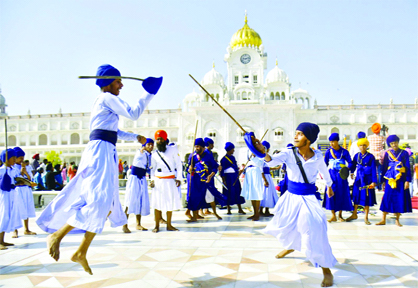
Ancient martial art of ‘stick-fighting’ was in vogue for self-defence since times immemorial and Sikh martial art ‘Gatka’, based on stick-fight, developed as self-defensive style after fourteenth century in old Punjab. It is associated with the Sikh history and an integral part of vast arena of Sikh Shastar Vidiya (skills to use weapons). The sixth Guru, Sri Guru Hargobind Ji had promoted the flamboyant techniques of Shastar Vidiya, (Sikh Martial Art), among the Sikhs who passed on these skills through generations. The tenth Guru, Sri Guru Gobind Singh Ji was known as the greatest master of weaponry of his time.
During the British colonial rule in India, the British rulers eventually banned Neja (now called as Javelin), Gatka and the Sikhs’ custom of carrying Kirpan (sword) to prevent rebellion and anti-colonial sentiments. During that time, Sikhs had to practice ‘Shastar Vidiya’ in secret and were often confined to rural areas. Due to such restrictions, many Indian martial arts including Gatka suffered a lot and survived as folk-sports in certain changed patterns.
History and Origin of Gatka
Gatka is a Punjabi word which literally translates to wooden sticks, which are used instead of swords. Having been passed down generations and preserved in Sikh history, Gatka uses the sword as the main weapon, amongst others. Sri Guru Har Gobind Singh Ji used to carry 2 swords- Miri and Piri, which stood for strength and spirituality, respectively. It is a form that can only be used to defend yourself and others only when all other means have failed.
The people who play it are called Nihangs, or armed Sikh warrior. During the 16th & 17th century, Gatka was extensively used by Sikh warriors to defend themselves from Mughals and their atrocities. Guru Gobind Singh Ji is known as the greatest Gatka warrior of all times.
Modern-day Gatka Practice
The Gatka performance that we see today was developed in the early 19th century. It has been divided into the traditional (Rasmi) and sports (Khel) style. As a sport, formal rules were drafted in 1936. Interestingly enough, Punjab University Patiala is the only place which offers a 1-year diploma course in mastering this art form. 75% of the total fee, which is Rs. 25,000 Is sponsored by the NGO ‘Sarbat da Bhala’ and the student only has to pay the remaining 25% of the fee.
Gatka is an integral and entertaining part of many Sikh festivals, processions, and Gurdwaras, especially post its revival and formalisation by the International Gatka Federation in 1987. Today, it is a proper sport which finds itself being played at the national level, courtesy of the Gatka Federation of India which was formed in 2008. It is a mark of the preservation and propelling of a dying yet a fine form of martial arts from the medieval times, encasing, upholding and safeguarding our rich culture and history.
Punjab government has now officially recognised Gatka as a sport in its policy, and the players enjoy the 3% quota during admissions, as do the players of other sports.
The Shastras
This art form has graduated from bare-hand combat to using swords, kirpans, lathis, axes, wooden sticks, and more. One starts with learning the basics with a wooden bamboo stick. Later, kirpans are used. They come in all shapes and sizes to suit an individual need.
Next, the shields are introduced. Even they come in various forms, varying from basic, simple ones to bulky, spikey ones. When one is adept with the use of these basic weapons, other Shastras are used to ace at this art form. The handling and use of those weapons can pose to be dangerous, and hence a strict level of discipline, concentration and proper technique is required to use them.
Shastras such as the Dastar (turban) or the Kamar Kasa (belt) are not used in combat but worn by the Nihangs to adorn themselves. Ranjit Nagara (the drum of victory) and reciting Gurbani are used to raise the spirits of the Sikhs and help them fight valiantly. Even these both are considered a Shastra used in Gatka.
Some other Shastras used in Gatka is as follows:
– Khanda (Double-edged Sword)
– Lathi (Quarterstaff)
– Gargaj (Mace)
– Tir Kaman (Bow & Arrow)
– Chakkar (Wagon wheel with weights at the spoke-ends)
During the learning, it is not just the fighting aspect that is taught. This art form is a unification of the body with the mind and the soul. A disciplined and dedicated form of training, along with a balanced mind is what this art form teaches you.
Gatka is a complete martial system which uses spiritual, mental and physical skills in equal portions to help one fully competent in defending themselves and others.
In addition to giving the student defensive skills, it also helps the individual with other aspects of their life: makes the mind alert and responsive, maintains the body in a near perfect condition and makes soul fearless, compassionate and tranquil.
The techniques involved are extremely effective for defence and attack as well as visually spectacular. The Sikhs mastered Gatka and perfected its use in battle. Many battles were won by the Sikhs, despite almost always numbering far fewer than the opposite forces. The techniques within Gatka were combined with the spiritual practices of the Sikhs to create a perfect fighting system. Opposing forces have documented how awesome these Sikhs were at battle!
The art of Gatka involves a series of integral combat training systems that include several systems of duels armed – unarmed and the use of weapons of defense and offence. It aims at the coordination of mind & body through the meditation of spiritual verses of Gurbani, a holistic system by which the character and moral attitude of a student is shaped.
The Technique
Gatka is primarily based on a variety of paitaras and asanas, which are forms for coordinating the entire body as well as weapons in harmony. The first is the Mul paitara, a basic four-step pattern that serves as the foundation for all subsequent forms. The movement requires equal and simultaneous use of both hands and develops ambidexterity. It is a balancing and coordination exercise that should be repeated. Then there are other paitaras based on the tiger, monkey, bull, snake, eagle, etc., that can also incorporate weapons.
Following the Ardas, the warriors bow before the weapons and salute the weapons, either approaching or circumambulating them. There are also the war cries like Sat Siri Akal and Gurbar Akal. Before sparring, both players must perform the fatehnama, or salute each other, by crossing and striking each other’s weapons twice.





Be the first to comment